Japan: A Stunning Country
Located in east Asia, the island country of Japan is one of the finest in the world. Popularly known as the ‘Land of the Rising Sun’, Japan has a lot to offer. I moved here last March and till date I’m in awe with the way this country and its people are. I’d like to let readers know a little about why life in Japan is great and what factors contribute to making it great.
As a kid, my mom always kept telling me how polite, considerate and hard working the Japanese are. She wanted to see those characteristics in me. The Japanese are undoubtedly a fine race of people from whom the world has a lot to learn. One can observe and experience Japanese hospitality and kindness right from the minute they step foot in any part of Japan. The way people are respected, treated and served in Japan is in itself a huge part of Japanese culture. People here are very mindful of others. They’d never talk loudly inside a train, bus or shopping complex. They are very helpful. They always come forward to help people in any possible way they can. If you ask them for a location, they’d go to the extent to drop you off at your desired location and ensure you’re OK. Japanese people are always ready to go that extra mile for the good of others.
Japan is probably the cleanest country on earth. The Japanese care about their surroundings and keep them extremely tidy at all times, however crowded the place may be. I hardly find litter in parks, train stations or on the roadside. The Japanese are almost obsessed with cleanliness. Its spiritual to them. Restrooms are kept very clean at all times of the day in any public space. Children are asked in schools to clean their tables before and after a meal. Also, at the end of the day, children need to clean their classrooms before they leave.
The kind of services and products this country has to offer is out of the world. Everything they offer is of the highest quality. Customers are given the best possible experience anywhere they go, be it a small cafe, a clothing showroom, a hospital or a tourist spot. The entire process of having a meal in a restaurant or shopping at a mall is very joyful, solely because of Japanese hospitality. If there is, by chance, an error in a product or service, the Japanese ensure that you are compensated well enough for the same. One would never go home with a bitter experience.
Japan always aims at offering its citizens and residents with systems and services that can help make life stress-free. Almost every street has got one or two 24*7 convenient stores that have basic things for daily use. They also have freshly packed food. There are plenty of Japanese restaurants, mostly family run, around too. I don’t spend a lot of time cooking in Tokyo because clean, fresh and healthy food is easily available at a very reasonable price. With a growing population of old aged people, senior citizen care has been designed very thoughtfully in this country. There are many care centers that are fully equipped and able to provide comprehensive daily care for the aged. This includes meals, cleaning, laundry, regular health checks and exercises or activities that aim at keeping them active and engaged. A whole lot of benefits are in place for expectant mothers too. Hospitals and clinics are very well kept and quality health care is provided round the clock.
Japan’s public transport network continues to amaze me each time I enter a railway station or get on a train or bus. With a very well connected and dense network of trains and buses connecting every bit of the country, Japan is ranked third in the world for it’s transport system. It is very reliable. They are very efficiently run and are almost never late. Till date, there have been very few instances wherein a train has not been on time. A couple of years back, I remember reading on the BBC that the Japan Railways company had stated “sincerely apologize for the inconvenience caused” after one of it’s trains departed 20 seconds early!
I can hardly imagine receiving an apology for a mistake of this kind anywhere else in the world. I am not surprised at all. This is how good the Japanese are. This in itself talks volumes about Japanese mannerism and how they value time and people in general. If you happen to visit Japan, never miss riding on the super fast Shinkansen bullet trains. One journey on the Shinkansen , or any local train for that matter, is enough for people to understand how good the transportation system in Japan is. For this part of the article about transportation, I really think I am at loss of words to describe it.
Another thing that I love about this country is its children. Japanese children are very well mannered. They rare raised to be responsible, caring and hard working. Public schools in Japan offer excellent education. The education system focuses on building a well rounded citizen with skills in every discipline of life you can think of, from science to music to carpentry. Lunch is provided in all government schools. The menu is designed by a nutritionist. There was a BBC article earlier this year that said Japan is among the top five countries in the world to raise children in.
This island is so full of tranquil and serene places. Shrines, Japanese gardens or a view from a train window that takes you to the suburbs of Tokyo – everything looks like a painted picture and instills calmness in you. This country is overwhelmingly populated with good hearted people. I am learning from them everyday. I’d like other countries and their people too to learn from Japan and build communities that care for people and respect them. The world should look upon Japan and draw inspiration.
All other content (text) created by the original author and © 2024 MUSUBI by Borderlink
Top Photo: kscz58ynk on PhotoAC
Japan, with its rich cultural tapestry and timeless traditions, has a unique approach to medicine and well-being that has captivated the world. Navigating the Japanese healthcare system can be a breeze with a few key insights. Firstly, it’s advisable to familiarize yourself with the local clinics, often known as “Iin” or “Kenshin,” where general practitioners address non-emergency medical concerns. While language barriers can be a challenge, major hospitals in urban areas often have English-speaking staff. Establishing a relationship with a local general practitioner ensures continuity of care and a better understanding of your health needs.
Eating Right
Staying healthy in Japan goes beyond medical visits. Embracing the Japanese diet, rich in fresh fish, vegetables, and green tea, can significantly contribute to well-being. The emphasis on portion control and a balance of nutrients align with the traditional Japanese concept of “hara hachi bu” – eating until you are 80% full. This mindful approach to eating is a cornerstone of the country’s remarkably low obesity rates and long life expectancy.
Clean the Body
One quintessential Japanese health practice is the ritual of bathing in onsen, natural hot springs scattered across the country. Beyond their aesthetic appeal, onsens offer therapeutic benefits owing to their mineral-rich waters. The minerals, such as sulfur and radium, are believed to alleviate various skin conditions, improve circulation, and reduce stress. Japanese culture places great importance on communal bathing, fostering a sense of unity and relaxation. Visitors should be aware of onsen etiquette, including thorough cleansing before entering the bath and refraining from bringing towels into the water.
Strengthen the Will
Japan’s commitment to preventive healthcare is also evident in its strong emphasis on physical activity. From traditional martial arts like judo and kendo to contemporary fitness trends, there is a broad spectrum of activities catering to diverse preferences. The Japanese government actively promotes a healthy lifestyle through initiatives like “metabo,” addressing metabolic syndrome through diet and exercise. Engaging in local fitness activities not only enhances physical health but also provides a cultural immersion, connecting residents and expatriates alike.
Clear the Mind
In addition to physical well-being, mental health is gaining recognition in Japan. The cultural concept of “forest bathing” or “shinrin-yoku” highlights the therapeutic benefits of spending time in nature. Parks and green spaces abound in Japan, offering urban dwellers a respite from the bustling city life. Furthermore, mindfulness practices such as meditation and yoga are gaining popularity, providing tools to manage stress and enhance overall mental resilience.
Conclusion
In conclusion, Japan’s holistic approach to health encompasses not only medical care but also dietary habits, communal practices like onsen bathing, and a commitment to staying active. Visitors and expatriates can unlock the secrets to longevity by embracing these facets of Japanese culture. As you navigate the vibrant streets of Tokyo or the serene landscapes of Kyoto, take a moment to savor the nutritious cuisine, immerse yourself in the soothing waters of an onsen, and perhaps join a local fitness class. In the intersection of tradition and modernity, Japan offers a blueprint for a healthy and fulfilling life.
Top Photo: kscz58ynk on PhotoAC
All other content (text) created by the original author and © 2024 MUSUBI by Borderlink
Welcome again to the Best of MUSUBI, where the past becomes the present and old articles get some new life!
In 2009, the US placed a temporary ban on Japanese beef imports due to an outbreak of foot-and-mouth disease. Doing so aided in increasing the international fame of one particular variety, as it suddenly became a highly-prized forbidden fruit of sorts. After the ban was lifted in 2012, the culinary world was fraught with stories of deceitful wannabes and overpriced imposters. It was best meat ever, if you were actually eating the real thing!
Whatever your opinion on Kobe beef- the real Kobe beef, that is- there is one thing that’s very hard to argue with: it’s pretty tasty. It’s also one of Kobe’s (and Japan’s) most famous products. Everyone can associate the brand ‘Kobe beef’ with Japan; I personally cannot name a single Japanese politician, but surely I know about Kobe beef. But what is Kobe beef exactly? Or to put it another way, what makes Kobe beef Kobe beef? After all, not just every cow from Kobe gets to be part of this exclusive club.
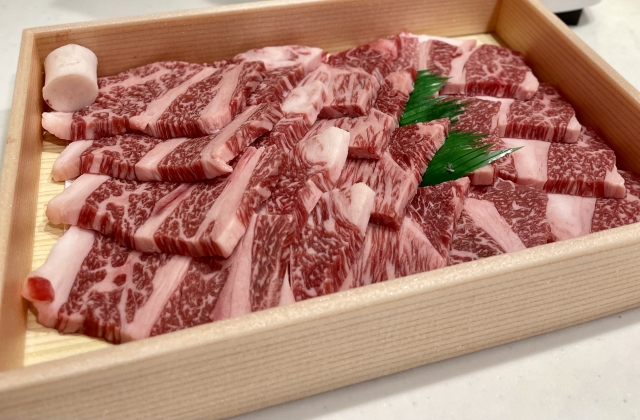
Photo by ともにん
Kobe beef comes from the Tajima-gyu breed of cattle found in Japan’s Hyōgo Prefecture, of which Kobe is the capital. Herd isolation and distinctive feeding techniques have contributed into ‘creating’ a unique meat in taste and texture.
Several stories about its special taste and origins surround this legendary beef: 1) Cows are given beer to induce appetite; 2) Cows are massaged every day; 3) Cows listen to classical music while eating. How much of this is true and how much is sensationalized depends on who you ask- an important part of Kobe beef is the mystique surrounding it- but there are some details that can be confirmed.
Kobe beef is not simply produced- it is a name that must be earned following approval from the Kobe Beef Marketing and Distribution Promotion Association. The requirements for what does and doesn’t qualify as Kobe beef are strict, and that extends all the way to the time it arrives on your plate.
True Kobe beef is a delicacy that often comes with a high price tag and is only served in the finest restaurants. The stuff you get overseas is often merely Kobe beef in name only, as there is no rigorous screening or grading process; any upscale restaurant can advertise itself as having Kobe beef, but that doesn’t mean it is Kobe beef. If you want the real deal, my best suggestion is to get it in Japan. It doesn’t necessarily have to be in Kobe, but then again, if you want to experience Kobe beef in its heartland, this is the place to do it.
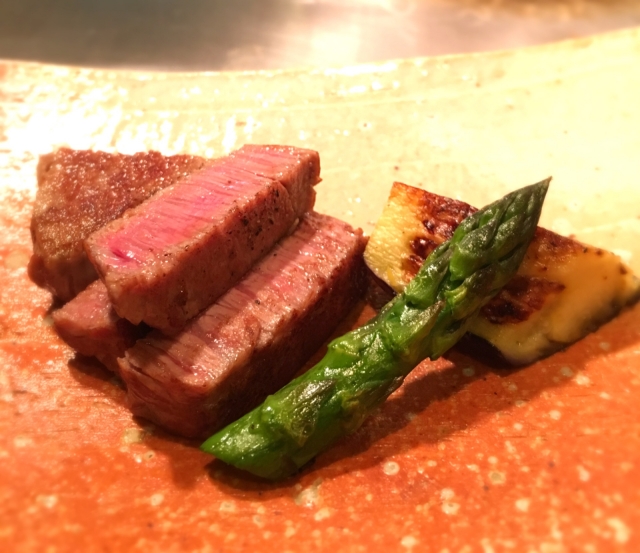
Photo by よなな
I tried Kobe beef once and it was incredible, like something that I had never tasted before. Unfortunately, it was also the only time, as Kobe beef is not something one can partake in often without expecting to shell out. As we’ve established, the Kobe beef brand name is highly protected and taken very seriously, which contributes to its high value. A Kobe beef steak can cost from 10,000 to 20,000 yen. Some can even cost over 30,000 yen! Despite the high price, it is absolutely worth trying at least once in your life.
If you have money and don’t mind spending it, then, I would recommend you few places where you can be served top-quality Kobe beef:
Kokubu (コクブ). Access: 5 mins walk from Sannomiya Station (三宮駅). Price Range: 10,000 -15000 yen and up. Serves some of the truly highest-grade stuff!
Steak and Grill Meriken Hatoba (ステーキ&グリル 神戸メリケン・波止場) is located in Kobe’s Chinatown. During the lunch time, they serve Kobe beef lunch dishes at very reasonable price, so the restaurant will get super crowded with visitors from all over Japan. Access: 2 mins walk from Motomachi Station (元町駅) Price Range: 4,000–5,000 yen.
Kobe Steak house Mouriya (神戸牛ステーキレストラン モーリヤ) is a 130-year long-established restaurant that offers well-aged Kobe beef. Access: 8 mins walk from Motomachi Station (元町駅). Price Range: 10,000–15,000 yen.
As I really like food and eating, I can surely say that Kobe beef is an experience that you cannot miss. Whether you live here already or are visiting some day, it’s a pricey but delicious delicacy worth partaking in!
Photo Credits:
Additional photos by ともにん and よなな
All other content (text) created by the original author and © 2024 MUSUBI by Borderlink
Top photo: ネコのめしつかい on PhotoAC
The history of cats in Japan spans centuries. Over a thousand years ago, they were kept as pets by members of the upper classes. They have featured in Japanese mythology as everything from shape-shifters to monsters to symbols of good fortune. And statistically speaking, anyone with even the slightest familiarity with social media has somehow seen a cat in Japan.
So Japan is definitely a hotspot for Cat Whisperers, Crazy Cat Ladies and Feline Aficionados from all over the globe. But where are the best places you can experience the cats of Japan short of actually owning one? Here’s my purr-sonal picks!
Cat Cafés

A typical Cat Café. Photo by Alexnewworld on Pixabay
This first one is a no-brainer. Cat cafés(猫カフェ) have been trending for quite some time now, but Japan has some of the best cat cafés, hands down, and this is coming from a person who has worked at a cat café and been to several others in the past. While the “MoCHA” cat cafés are part of a popular franchise in Japan, my best tip for people who want all the cats to themselves is to go to a cat café that is not as “mainstream”. That’s right! This is because the popular ones will always be full, and there will be too many humans in those cafés. It will be difficult to bond with the cats or even befriend a specific cat when there are all those pesky people trying to steal them away from you!
So, the following is a list of cat cafés that should help you avoid this problem:
• Cat Café Calico in Shinjuku
• Neko JaLaLa in Akihabara
• Asakusa Nekoen
• Iyashitei Hogonekochaya in Shinbashi
• Neko-no-iru Kyuukeijo 299 in Ikebukuro
• PuchiMarry in Kyoto
• Edo Cat Café in Tokyo
These are only a few that I would personally recommend, but I am sure there are more fabulous cat cafés out there where you can make new feline friends while enjoying a warm drink or sweets.
Cat Islands
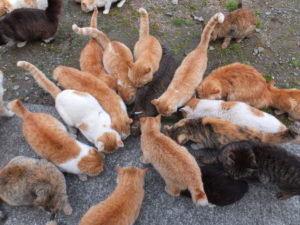
On these islands, cats rule. Photo by 暇・カキコ on Wikimedia Commons (CC BY-SA 4.0)
If you are someone who prefers the company of your feline friends over your human ones, and you want to escape the hustle and bustle of the café experience, then this is the route for you. You’ve probably imagined a life where you only need to interact with cats.
Whenever you feel like you need to get away from all that human-related stress, then pack your bags (don’t forget the cat food/treats/toys) and plan a trip to one of these cat islands. There are some popular ones in Japan that most people will know if they’ve done the research (i.e. googled “cat islands japan”), but here is a more comprehensive list:
• Aoshima (Ehime prefecture)
• Tashirojima (Miyagi prefecture)
• Enoshima (Kanagawa prefecture)
• Manabeshima (Okayama prefecture)
• Okishima (Shiga prefecture)
• Muzukishima (Ehime)
• Sanagishima (Kagawa prefecture)
• Iwaishima (Yamagushi prefecture)
• Aijima (Fukuoka prefecture)
• Aishima (Fukuoka prefecture)
• Genkaishima (Fukuoka prefecture)
• Kadarashima (Saga prefecture)
Cat Temples and Shrines
If you cannot afford to go to the cat islands (since most of them are in the more rural areas), then going to a cat temple or shrine is another alternative. One of the most famous ones is Gotokuji Temple in Setagaya.
At these cat temples or shrines, it is not uncommon to see lots of maneki-neko statues and ema plaques decorated near the entrance of the temple or the gift shop.
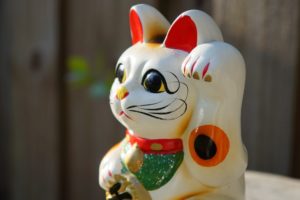
The maneki-neko or “beckoning cat”. Photo by angelsover on Pixabay
Visitors can write wishes for their cats on the ema plaques and hang them up in a special area. As someone who has 16 cats back in my hometown, a cat shrine or temple is definitely going on my “Top 10 Places to Visit Before I (or My Cats) Die” list. There is also another smaller cat shrine in Asakusa called Imado Shrine, which also has a gift shop where you can buy omamori (good luck) charms for your cat.
The Legacy of Japan’s Celebrity Cat, Tama
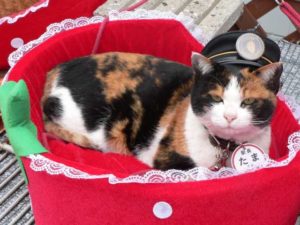
Pay your respects to Station Master Tama. Photo by Takobou at the Japanese language Wikipedia (CC BY-SA 3.0)
This cat is so famous, she even has her own book! And the book is available in several languages too. My younger brother even found a copy in Malay somewhere in Malaysia (where I was born), so this cat’s fame is no joke.
Tama was the station master of Wakayama’s Kishi Station from 2007 to 2015. Unfortunately, Tama recently passed away in 2015, so her fans can’t visit her anymore at the station, but we can still visit her successors, Niitama and Yontama. There are even special trains named after Tama, like ‘TAMADEN’. If you are planning on visiting Kishi station to meet these very ‘busy’ station masters, I suggest you check their working schedules first. More information on their schedules should be available on the official Wakayama Dentetsu site: https://www.wakayama-dentetsu.co.jp/en/
These are only some cat-themed attractions in Japan, but there could be many more out there waiting to be discovered. If you are a tourist with a feline family member waiting for you in your home country while you are travelling, or if you are a long-term resident in Japan who wants to have a pet cat, but cannot afford to have one yet due to your current accommodation type, then you simply have to check these spots out! They’re the next best thing to having your own nine-lived family member!
Now that the cat’s out of the bag on the best cat places in Japan, why not find your own? For more information on how you too can experience Japan, read all about the job of an ALT !
Photo Credits:
Top photo: ネコのめしつかい on PhotoAC
1 – Alexnewworld on Pixabay
3 – “Cats in aoshima island 2” by 暇・カキコ licensed under the Creative Commons Attribution-Share Alike 4.0 International license. (cc-by-SA-4.0). No changes or alterations were made. Wikimedia Commons Link
4 – angelsover on Pixabay
5 – “Station-Master Tama” by: Takobou at the Japanese language Wikipedia , licensed under the Creative Commons Attribution-Share Alike 3.0 Unported license. Subject to disclaimers. (cc-by-SA-3.0) No changes or alterations were made. Wikimedia Commons Link
All other content (text) created by the original author and © 2024 MUSUBI by Borderlink

